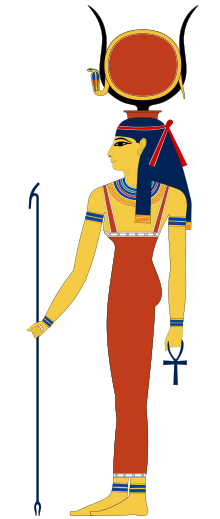Hathor
| Hathor | |||
|---|---|---|---|
| Goddess of the sky, dance, love, beauty, joy, motherhood, foreign lands, mining, music and fertility. | |||

The goddess Hathor wearing her headdress, a sun disk with Uraeus set between the cow-horns
|
|||
| Name in hieroglyphs |
|
||
| Major cult center | Dendera | ||
| Symbol | the cow, lioness, falcon, cobra, hippopotamus, Sistrum, musical instruments, drums, pregnant women, mirrors, cosmetics | ||
| Consort | Ra, Horus | ||
| Parents | Neith and Khnum or Ra | ||
| Siblings | Ra, Apep, Thoth, Sobek, Serket | ||
| Offspring | Ihy, Horus,Imsety, Hapi, Duamutef, Qebehsenuef | ||
| Nebethetepet in hieroglyphs | ||||||
|---|---|---|---|---|---|---|
nb.t htp.t mistress of the offering |
||||||
Hathor (/ˈhæθɔːr/ or /ˈhæθər/;Egyptian: ; in Greek: Ἅθωρ, meaning "mansion of Horus") is an Ancient Egyptian goddess who personified the principles of joy, feminine love, and motherhood. She was one of the most important and popular deities throughout the history of Ancient Egypt. Hathor was worshipped by royalty and common people alike. In tomb paintings, she is often depicted as "Mistress of the West," welcoming the dead into the next life. In other roles, she was a goddess of music, dance, foreign lands, and fertility. She was believed to assist women in childbirth. She was also believed to be the patron goddess of miners.
The cult of Hathor predates the historic period, and the roots of devotion to her are therefore difficult to trace, though it may be a development of predynastic cults which venerated fertility, and nature in general, represented by cows.
Hathor is commonly depicted as a cow goddess with horns in which is set a sun disk with Uraeus. Twin feathers are also sometimes shown in later periods as well as a menat necklace. Hathor may be the cow goddess who is depicted from an early date on the Narmer Palette and on a stone urn dating from the 1st dynasty that suggests a role as sky-goddess and a relationship to Horus who, as a sun god, is "housed" in her.
...
Wikipedia
